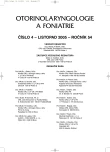-
Medical journals
- Career
The Importance of MitoticApoptotic Index and DNA Flow Cytometry in the Prognosis of Head and Neck Cancer
Authors: P. Smilek 1; L. Dušek 2; K. Veselý 3; R. Kostřica 1; J. Rottenberg 1
Authors‘ workplace: Klinika ORL a chirurgie hlavy a krku LF MU a FN U sv. Anny, Brno ; přednosta prof. MUDr. R. Kostřica, CSc. Centrum biostatistiky a analýz, Lékařská a Přírodovědecká fakulta MU, Brno 1; přednosta doc. RNDr. L. Dušek, Ph. D. 1. patologicko-anatomický ústav FN u sv. Anny, Brno 2; přednosta prof. MUDr. A. Rejthar, CSc. 3
Published in: Otorinolaryngol Foniatr, 54, 2005, No. 4, pp. 199-205.
Category: Original Article
Overview
Summary:
The objective of the study was to analyze prognostic importance of the biomarkers p53, Ki67, mitotic and apoptotic index and flow cytometry analysis of the cell cycle of head and neck cancer in relation to Event Free Survival (EFS) and Overall Survival (OS).Material and Methods:
the analysis was made in a group of 77 patients with head and neck cancer, who were treated at the Clinic of Otorhinolaryngology and Head and Neck Surgery at Brno in the years 2003–2005. In addition to common types of examinations (determination of localization, extent and possible metastases of the tumor histological examination), flow cytometric analysis of DNA was performed and the Ki-67 and p53 markers were examined by immunohistochemistry.Results:
the tumor was localized in 31.2% of patients in nasopharynx and on the lateral wall of oropharynx, in 58.4% on the tongue root and in supraglottis and in 10.4% in hypopharynx. The IIIrd and IVth clinical stage of TNM classification was encoundeted in 83.1% of the treated patients. Histopathological grading 1 or 2 was established in 77.9% of patients. The median survival was 39.7 months. The evolution of the disease risk during the first 6 months appears to be independent of common clinical categories, specifically on staging and localization. The prognosis of low-advanced tumors (T1–2) and simultaneous low-differentiated tumors (G3–4) proved to be better (p=0.034). The prognosis of diploid and p53 negative tumors was better (p=0.222).Conclusions:
the evaluation of kinetic parameters of the cell cycle univocally revealed a significantly lower proportion of cells in the S phase (named SPF) in tumor of poor prognosis. Tumors with a direct progression immediately after the therapy included a significantly higher proportion the cells in G2/M phase. The definition of poor or good prognosis is based on the ratio of SPF and G1/M phase.Key words:
head and neck cancer, prognosis, proliferation-apoptotic index, DNA flow cytometry.
Labels
Audiology Paediatric ENT ENT (Otorhinolaryngology)
Article was published inOtorhinolaryngology and Phoniatrics

2005 Issue 4-
All articles in this issue
- Shaver (Microdebrider) in Otorhinolaryngology
- The Role of Sleep Monitoring in the Diagnosis of Obstruction Syndrome of Sleep Apnea
- Cholesteatoma and Fistula of Bone Labyrinth
- The Importance of MitoticApoptotic Index and DNA Flow Cytometry in the Prognosis of Head and Neck Cancer
- Xerostomia: Etiology, Therapeutic Possibilities, Recommendation to Patients
- Anomalous Course of Internal Carotid Artery as a Cause of Massive Perioperative Hemorrhage from Middle Ear
- Langerhans‘ Cell Histiocytosis and Its Manifestation in Temporal Bone (Eosinophilic Granuloma of the Temopral Bone)
- Otorhinolaryngology and Phoniatrics
- Journal archive
- Current issue
- Online only
- About the journal
Most read in this issue- Xerostomia: Etiology, Therapeutic Possibilities, Recommendation to Patients
- Shaver (Microdebrider) in Otorhinolaryngology
- Langerhans‘ Cell Histiocytosis and Its Manifestation in Temporal Bone (Eosinophilic Granuloma of the Temopral Bone)
- Cholesteatoma and Fistula of Bone Labyrinth
Login#ADS_BOTTOM_SCRIPTS#Forgotten passwordEnter the email address that you registered with. We will send you instructions on how to set a new password.
- Career

